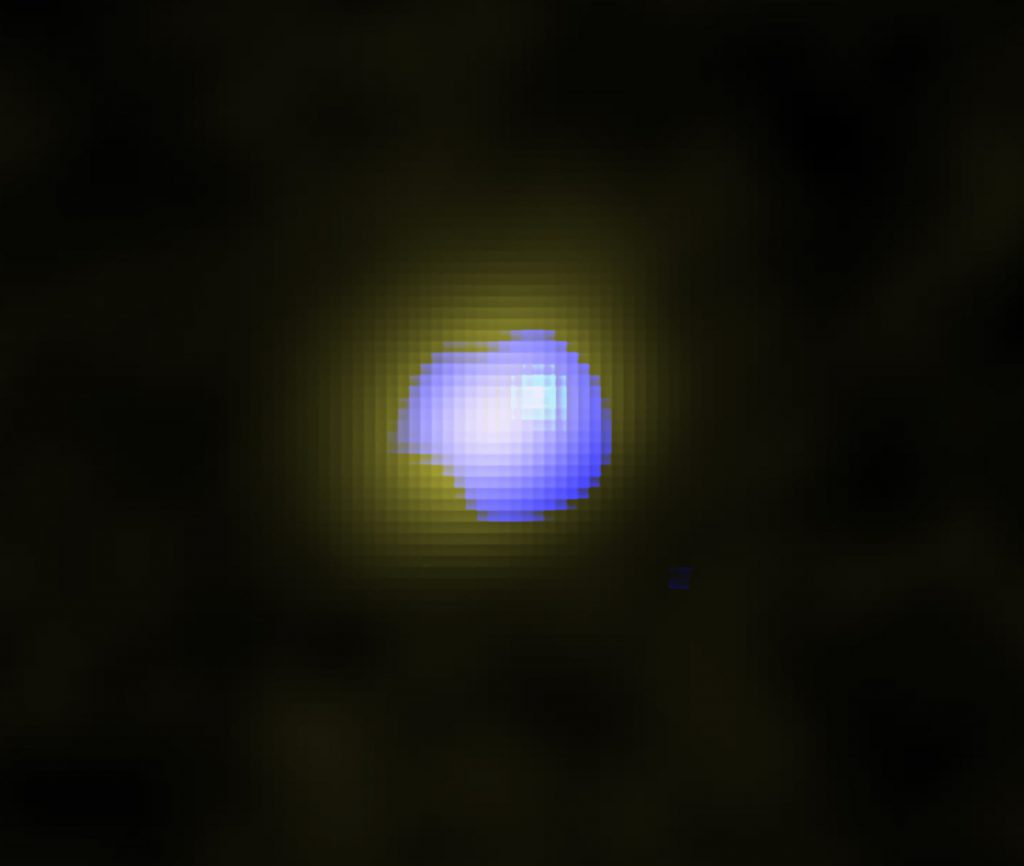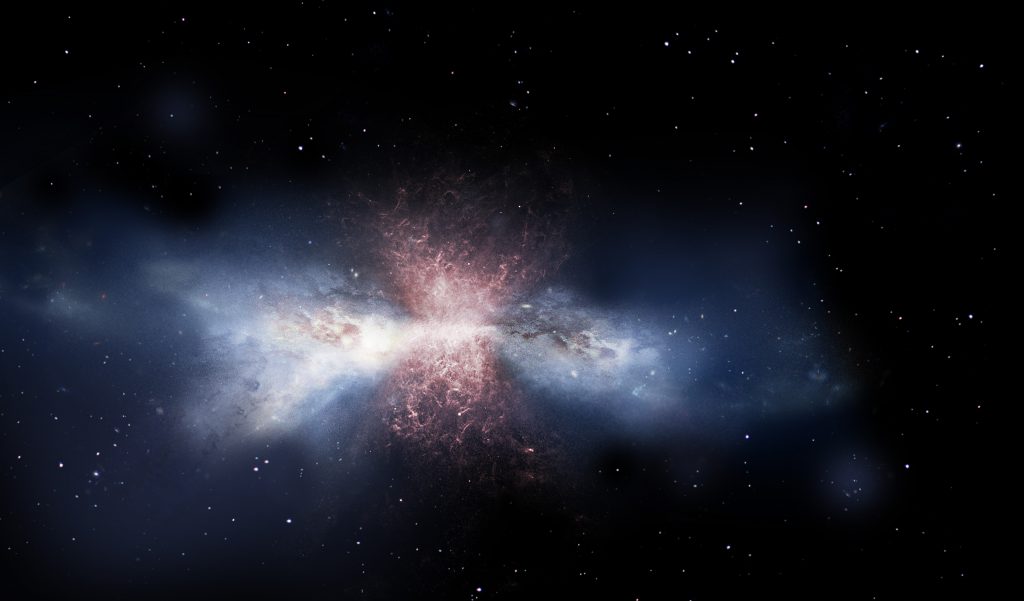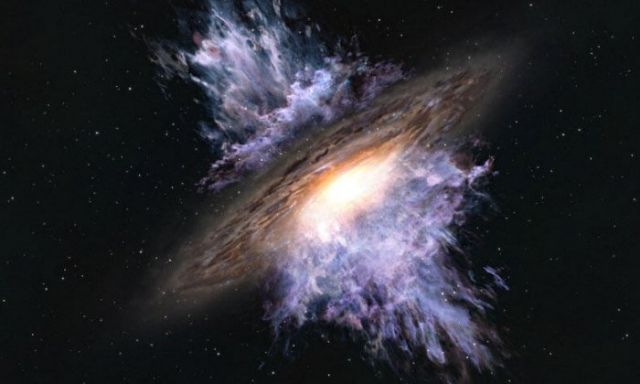The Black Hole Superstorm Raging in the Early Universe!
In the far depths of time of the early universe, a supermassive black hole causes chaos.
by Rida Fatima
The Discovery
Using a device called Atacama Large Millimeter Array (ALMA), researchers at the National Institute of Natural Sciences have discovered a humongous galactic storm (otherwise known as a quasar wind) caused by a supermassive black hole within the early universe.

Source: ALMA/ESO/NAOJ/NRAO
To understand the significance of these findings, there are a few questions that need to be answered.
What is a Supermassive Black Hole?
Many galaxies have one supermassive black hole usually located in their centers. Our Milky Way has one named Sagittarius A* (pronounced as “Sag A-star”), although it doesn’t appear to be as active as the supermassive black hole reported from those recent findings from ALMA. Just like regular black holes, supermassive black holes don’t normally separate from their galaxies. However, what distinguishes them from normal black holes is that they’re essentially the heart of their entire galaxy, as they’re generally situated at the center of their respective galaxies. They’re also the most massive singular objects in their galaxy, and their gravitational pull is significant enough to cause everything else in their galaxy to revolve around them as a result.
What did we learn from this discovery?
One of the most unique things about supermassive black holes is that their mass is normally proportional to the mass of the galaxy’s internal or central region, even though there’s 10 orders of magnitude worth of difference between their sizes. Why is this unique? Because galaxies have an incredibly larger size and mass than their supermassive black holes, and while proportionality of mass can still exist between both objects, the difference in size usually makes it negligible. Yet in this particular case the proportionality was significant. In fact, this discovery actually supports a very widely accepted coevolution theory about the birth of galaxies and supermassive black holes.
Now despite all of these data, there is still one question that we don’t know the answer to, at least according to the lead researcher behind this discovery of an early universe supermassive black hole, Dr. Takuma Izumi, who stated;
“The question is when did galactic winds come into existence in the Universe? This is an important question because it is related to an important problem in astronomy: How did galaxies and supermassive black holes coevolve?”
What Makes this Discovery so Important?

Superstorms, otherwise known as galactic winds, aren’t a new phenomenon for our understanding. In fact, this isn’t even the first time a superstorm has been observed by scientists. However, this discovery is significant due to the following reasons;
· It’s the earliest observed example of a quasar wind phenomenon to date
· The discovery itself has created a debate around the creation of galaxies and the coevolution theory.
· The kinetic energy possessed by these galactic winds is significant enough to shift entire star systems from their original positions to other sections of space within the black hole’s vicinity.
The above mentioned points hypothesize that these winds may have been the catalysts for birthing entire star systems.
What are Superstorms and why are they Important?

What makes supermassive black holes so unique is their role in creating galaxies.
Well in order to understand this role, one theory worth mentioning is the coevolution theory. This theory states that the existence of scaling relations like proportionality of mass between the SMBH and its host galaxy show that their presence is not coincidental, but rather that SMBHs and their hosts have a shared evolution.
Now let’s break this theory down into simpler terms. According to this theory, a galaxy starts out when a supermassive black hole generates titular superstorms or galactic winds, through a process called stellar feedback, which is the release of huge amounts of energy into space by massive stars.
Since black holes themselves are a byproduct of a collapsed star, stellar winds are a common property of black holes, and are much more prominent with supermassive black holes. The energy from this stellar feedback is what essentially creates galactic winds.
Next, these powerful winds blow any material and space debris within the black hole’s vicinity to other sections of space surrounding the black hole and forming stars, planets and ultimately creating a new galaxy. Spilker, one of the ALMA researchers that discovered this phenomenon elaborated further on it stating;
“It is not a gentle, constant breeze, but isolated eruptions that expel gas at the same rate at which it would be transformed into new stars”
While this isn’t the only theory about how galaxies are formed, there are two important points about this discovery that actually support the coevolution theory.
1. A lot of researchers believe that the proportionality between the supermassive black hole and its galaxy is actually a sign that they evolved together at the same time.
2. We did learn that this galactic wind is strong enough to actually move entire stellar systems and may have caused stars to form in the J1243+0100 galaxy.
But these discoveries are being seen as convincing proof that supermassive black holes form galaxies and that galactic winds or superstorms generated from them are the main catalysts behind all of this.
What does this discovery mean for us?
Not only does the coevolution theory seem to be one of the more probable explanations behind how galaxies were formed but it also adds another aura of intrigue surrounding black holes and what they are truly capable of. Additionally, Dr. Izumi believes his discovery gives a pretty good idea about when galaxies started forming. He stated;
“Our observations support recent high-precision computer simulations which have predicted that coevolutionary relationships were in place even at about 13 billion years ago”
Takeaway
Simply put, superstorms are an essential source of creation born from a force of destruction, and considering the amount of evidence associated with this discovery, this statement does hold some credible weight to it. Dr. Izumi himself seems pretty optimistic about this theory stating;
“We are planning to observe a large number of such objects in the future, and hope to clarify whether or not the primordial coevolution seen in this object is an accurate picture of the general universe at that time.”
Of course, there is still one glaring question that even Dr. Izumi doesn’t know the answer to. Where did galactic winds come from? And if that is the case, then how? There still has to be a source of matter that created them. While this research has indeed disclosed a lot of important information, it has also created many more questions about the nature of black holes, further adding to their inexplicable reputation.
If you are interested in reading the full research about this discovery, be sure to check out The Astrophysical Journal, where this finding has been documented in great detail.
References
https://academic.oup.com/mnras/article/421/4/3522/1097848#19823717
https://escholarship.org/uc/item/2sj00888
https://iopscience.iop.org/article/10.3847/1538-4357/abf6dc
Rida Fatima is a graduate of biosciences from Pakistan. Her future goal is to pursue a career in astrobiology and to work to spread astronomy and space sciences awareness in her home country. As an author, she loves to write about the mysteries of the cosmos.
